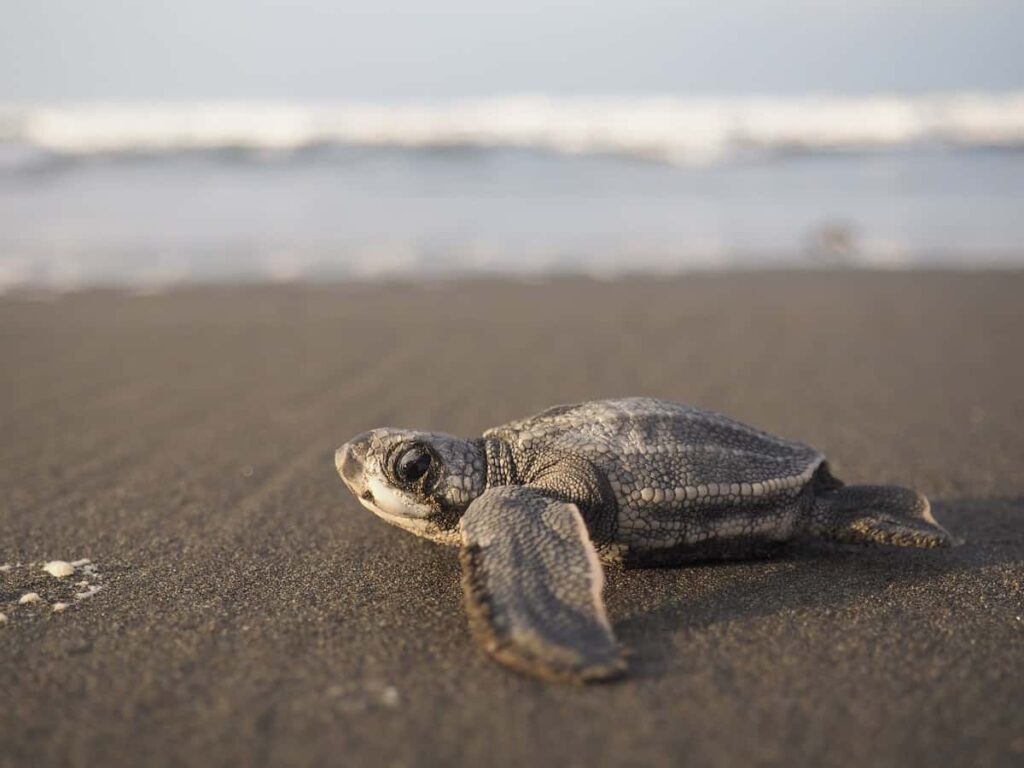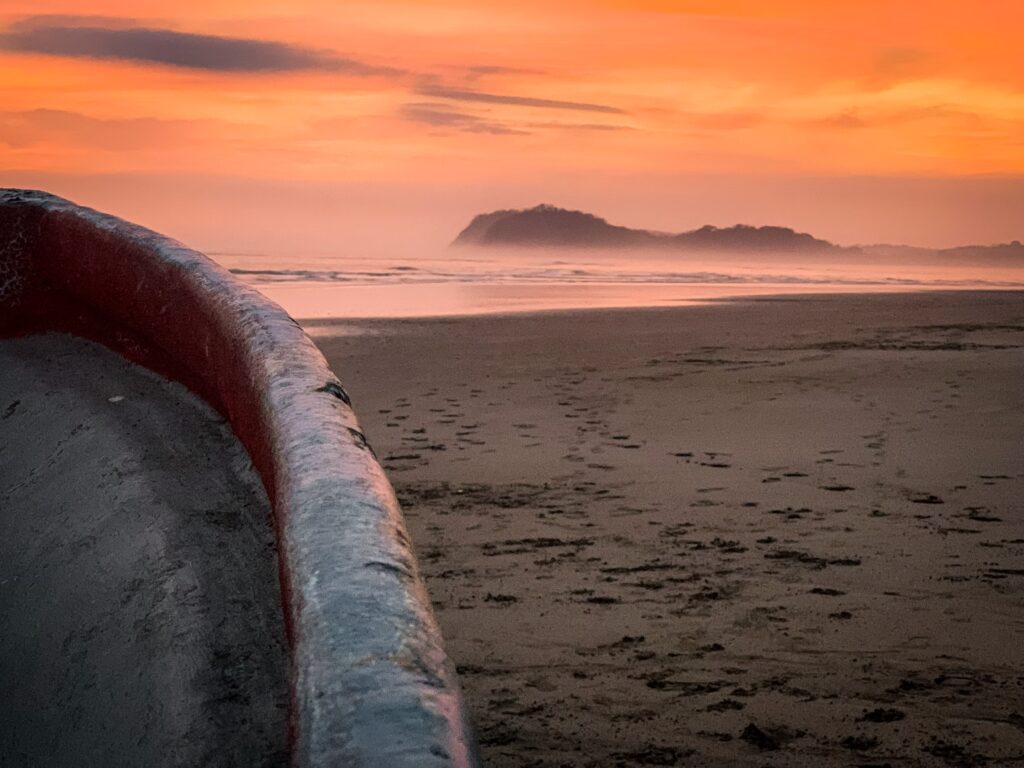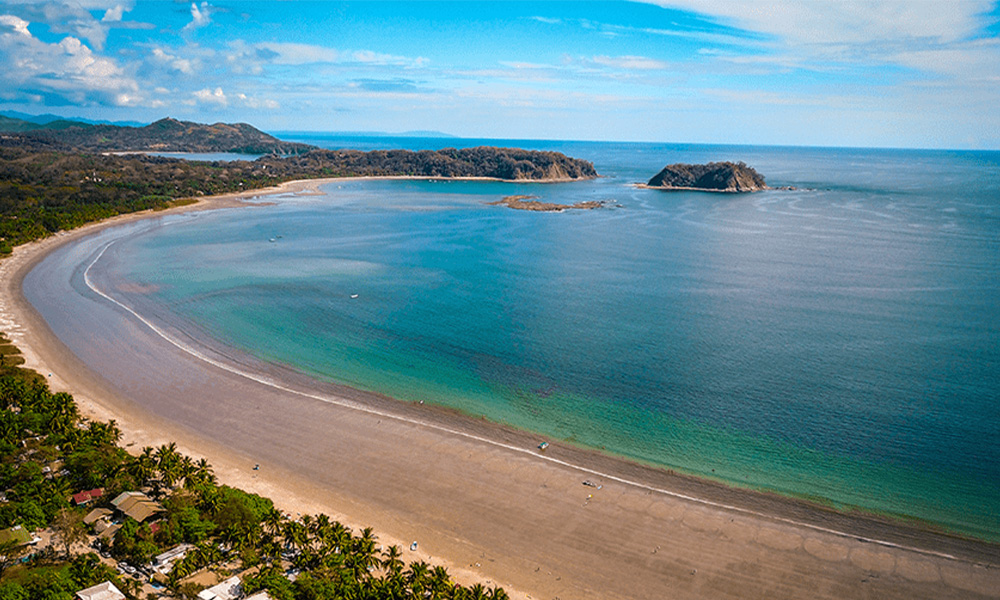
If you want a Costa Rica beach town with calm water, a walkable center, and a laid-back vibe that still has everything you need, pick Sámara. Tucked into a crescent bay on the southern flank of Guanacaste’s Nicoya Peninsula, Sámara pairs mellow waves with small-town charm.
The bay’s protective shape keeps conditions friendlier than many Pacific beaches, which means easier swimming days, beginner surf, and reliable mornings for kayaking or stand-up paddle. Add a palm-fringed shore, a compact main street, and quick side trips, and you get a base that works for couples, families, and first-timers who want pura vida without chaos.
Why Sámara Works
Sámara blends calm water, a compact town center, and easy day trips into one low-stress base. It’s built for simple routines: morning ocean time, lazy lunches, and sunset on the sand.
Calm, swimmable bay. The shoreline arcs into a natural cove that softens heavy swell. You still respect currents and check conditions, but most days feel approachable for casual ocean time.
Walkable town. The center sits at the beach edge, so you can stroll from your lodging to cafes, surf schools, fruit stands, and tour operators in minutes. No car needed for daily life.
Easy water sports. You can learn to surf on forgiving sandbars, paddle to a tiny offshore islet, or try gentle-pace snorkeling on clear mornings. Sunset swims are routine.
Service without sprawl. You get groceries, ATMs, pharmacies, and clinics nearby, yet the skyline stays low and the pace stays slow.
Great pairing with Playa Carrillo. Ten minutes south sits a postcard-perfect crescent with coconut palms and fewer vendors. Spend the day at Carrillo, then return to Sámara for dinner.
Where It Is and How to Get There
Sámara is in Nicoya, Guanacaste. From Liberia’s international airport (LIR), expect roughly a two-hour drive in normal conditions via paved highways through the city of Nicoya. From San José (SJO), plan on four to five hours depending on traffic and weather.
Public buses connect through Nicoya, and shared shuttles cover the main airport routes if you prefer not to rent a car. For dirt backroads north and south of town, a high-clearance vehicle is helpful in the green season; on the paved approach to Sámara itself, a standard car is usually fine.
When to Go
Pick dry season for maximum sun or green season for lush hills and lighter crowds. Either way, plan water activities early when wind and swell are lowest.
Dry season (Dec–Apr): Sunniest skies, dustier roads, and the highest demand. Ocean mornings are often glassy, afternoons can pick up a breeze, and sunsets are consistent.
Green season (May–Nov): Lush hills, lighter crowds, and better values. Expect afternoon showers and a few heavy systems each year. Mornings are typically calmest for paddling, snorkeling, or surf lessons.
Holiday notes: Christmas–New Year’s and Easter Week book up far in advance. If those dates are your only window, reserve rooms and car rentals early.
What to Do

Base your days around beginner-friendly surf, short paddles, and beach time. Add quick side trips to keep variety high without overplanning.
1) Paddle or kayak to Isla Chora
From the south end of the bay, it’s a short paddle to a tiny offshore islet with a pocket beach. Go early for calm seas and better visibility. Wear a PFD, check tides and wind, and bring sun protection plus a dry bag for phone and keys.
2) Learn to surf on friendly sandbars
Sámara’s inside reform waves are forgiving. Take a beginner lesson to dial in stance and pop-up, then rent a soft-top for solo practice sessions. Time lessons around the best tide window for the day.
3) Snorkel on clear mornings
Water clarity varies with swell and wind, but calm days can reveal small reef fish, urchins, and the occasional ray near rocky areas. Use fins, keep your distance from marine life, and avoid standing on rock or coral.
4) Day trip to Playa Carrillo
Pack a cooler, pick a palm, and spend an unhurried day at one of Guanacaste’s prettiest beaches. Facilities are minimal, which is part of the charm. Early morning and late afternoon light are ideal for photos.
5) Horseback rides and beach cruising
Local operators run beach-to-jungle rides that time sunset on the sand. If horses aren’t your thing, rent bikes and roll the compact streets for smoothies, ceviche, and sunset viewpoints.
6) Yoga, massage, and slow mornings
Sámara’s wellness scene is present but unpretentious. Join a drop-in class, then drink your coffee with toes in the sand and let the day decide itself.
7) Turtle watching (seasonal)
If your dates overlap with turtle nesting windows at nearby refuges on the Nicoya coast, book a guided night visit through licensed operators. Expect strict red-light rules and “no-touch, no-flash” protocols. Worth the planning when timing works.
A 3-Day, Low-Stress Plan

Use a simple framework: orient on day one, water focus on day two, and a Carrillo contrast on day three. Keep afternoons flexible for weather and energy.
Day 1: Arrive + Orient
- Morning or midday: Check in, drop bags, and walk the beach to understand the shoreline and sandbars.
- Afternoon: Smoothie bowl, then a light paddle or bay swim if wind is gentle.
- Sunset: Find the waterline, watch the sky go orange, and keep evening simple with a beachfront dinner.
Day 2: Water Focus
- Early: Guided kayak or SUP to Isla Chora. Swim and relax on the tiny beach.
- Late morning: Brunch in town, siesta, or hammock time.
- Afternoon: Beginner surf lesson timed to forgiving tide and swell.
- Evening: Casual seafood, ice cream, and early night.
Day 3: Carrillo Contrast
- Morning: Head to Playa Carrillo with a cooler and shade. Swim, read, nap.
- Afternoon: Stop at overlook pull-offs for photos, then return to Sámara for coffee and a final ocean dip.
- Sunset: Beach stroll, souvenir stop for local crafts, and a last dinner watching the shorelights come on.
Where to Stay
Small beachfront hotels, boutique guesthouses, and apartment suites cover most needs. Prioritize walkability and sleep quality over extras you won’t use.
Beachfront small hotels: Steps from the sand and close to everything. You trade resort frills for the pleasure of walking out barefoot.
Boutique guesthouses: Quiet back-street picks with gardens, hammocks, and small pools. Good for couples.
Apartments and family suites: Kitchenettes and extra space near the beach. Useful if you like self-catering breakfast and snacks.
Tips: Book walkable locations so you can skip parking headaches. Ask about AC vs. fans, blackout curtains, and water pressure if those matter to you. In green season, confirm if rooms have good cross-ventilation and screens.
Food and Drink
Expect fresh seafood, classic Costa Rican plates, and solid coffee culture. Prices scale with proximity to the sand, so mix beachfront views with back-street value.
Breakfast: Smoothie bowls, gallo pinto plates, and proper espresso are easy to find. Try a Costa Rican casado at lunch for a budget-friendly sampler of rice, beans, plantains, salad, and your protein of choice.
Seafood: Expect fresh mahi, snapper, and shrimp. Ceviche as a starter never offends. Keep an eye out for daily chalkboard specials.
Snacks: Fruit stands, coconut vendors, and small bakeries fill the gaps between dips. Hydrate often.
Evenings: This is not a party town by default. You will find beach bars and live music nights, but most visitors prioritize sunset and early mornings over all-night scenes.
Safety and Ocean Sense
Calm doesn’t mean risk-free. Read the water, respect rips, protect your skin, and keep a minimalist setup on the beach.
- Learn to identify rip currents. If caught, stay calm, float, and swim parallel to shore before angling back in.
- Mornings generally bring the calmest water for paddling and snorkeling.
- Wear footwear around rocky tide zones and be cautious near urchins.
- Sunscreen, hats, and rash guards are better than sunburn. Reapply after every session.
- Keep valuables minimal on the beach. Use hotel safes and dry bags.
Practical Logistics

Cards work widely, cash helps with small vendors, and cell data is solid in town. A standard car is fine for the main approach; upgrade if you’ll roam backroads.
Money: Cards are widely accepted in town. Carry some cash for smaller kiosks, taxis, and tips. ATMs are available.
Connectivity: Cellular data is solid in the center. Coverage drops on rural dirt roads and some coastal nooks.
Transport: For the paved in-and-out routes to Sámara, standard sedans work most of the year. If you plan side routes on rougher backroads, get higher clearance, especially in the heart of the green season.
Health: Pharmacies carry basics. Bring any special meds, reef-safe sunscreen, and insect repellent. Hydrate more than you think you need.
Community etiquette: Keep music low, pack out trash, and use beach showers to rinse before heading back through town. Respect “no drone” signs and wildlife buffers.
Budget Snapshot
Costs hinge on season and activity mix. Save with group lessons and sodas; spend where it matters, like guided paddles and well-located lodging.
- Surf lesson: Typically priced for 1.5–2 hours with board and rash guard included. Private lessons cost more; group lessons save money.
- Kayak/SUP to Isla Chora: Guided tours include gear, dry bags, and water. DIY rentals are cheaper but require tide and wind savvy.
- Meals: Breakfast cafés are moderate, lunch sodas are the best value, and seafood dinners scale with location and catch.
- Lodging: Nightly rates swing with season. Dry-season holidays command premiums; shoulder months yield deals.
Who Sámara Suits Best
Sámara favors beginners, families, and travelers who want ease over intensity. If your ideal day is ocean, eat, nap, repeat, you fit the profile.
- Beginner or casual ocean goers who want safe-feeling, low-drama water time.
- Families that prefer short walks, reliable services, and a calmer rhythm.
- Remote workers aiming for simple routines: morning swim, midday focus, sunset beach reset.
- First-timers to Costa Rica who want an easy landing zone before exploring farther afield.
- Couples who value sunsets and quiet streets more than nightlife.
Quick Do’s and Don’ts
A few habits maximize the trip: plan mornings, pack light, and tread gently. Avoid sunburn, risky entries, and leaving stuff unattended.
Do
- Book early for peak holidays.
- Schedule water activities for early morning windows.
- Bring a dry bag, reef-safe sunscreen, and a reusable water bottle.
- Try both Sámara and Carrillo to feel the contrast.
Don’t
- Underestimate the sun or rip currents.
- Stand on rock or coral while snorkeling.
- Leave valuables unattended on the beach.
- Assume every backroad is passable after heavy rain.
Nearby Add-Ons If You Have Extra Days

When you want a change of pace, head for Nosara’s surf, Palo Verde’s wetlands, or Nicoya’s plazas. Each adds variety without long drives.
- Nosara: Bigger surf and a robust yoga scene north of Sámara.
- Palo Verde wetlands: An inland boat safari to spot crocs and wading birds.
- Nicoya town: Colonial-era church, plazas, and a mellow half-day of culture and errands.
- Waterfall dips: Ask locally for current access info and road conditions before you go.
Pack List for a Low-Friction Trip
Bring sun gear, water footwear, and a dry bag. Add insect repellent and light rain layers in the green season to stay comfortable.
- Light rash guard and quick-dry shorts
- Sun hat, polarized sunglasses, and solid sunscreen
- Sandals plus water shoes for rocky entries
- Reusable bottle, small first-aid kit, insect repellent
- Dry bag and phone leash for paddling
- Lightweight rain shell in green season
- Copies of documents and offline maps
The Takeaway
Sámara is the practical choice when you want Costa Rica beach time without stress. The bay stays friendly, the town stays walkable, and day trips remain simple. Wake early for glassy water, nap under palms at Playa Carrillo, and watch the sky melt at sunset. That’s the rhythm. Keep plans light, listen to the ocean, and let the days stretch. You will leave rested, salted, and already plotting your return.

